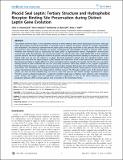Files in this item
Phocid seal leptin : tertiary structure and hydrophobic receptor binding site preservation during distinct leptin gene evolution
Item metadata
| dc.contributor.author | Hammond, John Anthony | |
| dc.contributor.author | Hauton, Chris | |
| dc.contributor.author | Bennett, Kimberley A. | |
| dc.contributor.author | Hall, Ailsa Jane | |
| dc.date.accessioned | 2012-07-19T12:01:02Z | |
| dc.date.available | 2012-07-19T12:01:02Z | |
| dc.date.issued | 2012-04-19 | |
| dc.identifier | 22351694 | |
| dc.identifier | 5a531557-5ba9-44eb-b20d-3320356a6c4c | |
| dc.identifier | 84859823930 | |
| dc.identifier.citation | Hammond , J A , Hauton , C , Bennett , K A & Hall , A J 2012 , ' Phocid seal leptin : tertiary structure and hydrophobic receptor binding site preservation during distinct leptin gene evolution ' , PLoS ONE , vol. 7 , no. 4 , pp. e35395 . https://doi.org/10.1371/journal.pone.0035395 | en |
| dc.identifier.issn | 1932-6203 | |
| dc.identifier.other | ORCID: /0000-0002-7562-1771/work/47136272 | |
| dc.identifier.uri | https://hdl.handle.net/10023/3003 | |
| dc.description | This work was supported by funds from the UK Natural Environment Research Council | en |
| dc.description.abstract | The cytokine hormone leptin is a key signalling molecule in many pathways that control physiological functions. Although leptin demonstrates structural conservation in mammals, there is evidence of positive selection in primates, lagomorphs and chiropterans. We previously reported that the leptin genes of the grey and harbour seals (phocids) have significantly diverged from other mammals. Therefore we further investigated the diversification of leptin in phocids, other marine mammals and terrestrial taxa by sequencing the leptin genes of representative species. Phylogenetic reconstruction revealed that leptin diversification was pronounced within the phocid seals with a high dN/dS ratio of 2.8, indicating positive selection. We found significant evidence of positive selection along the branch leading to the phocids, within the phocid clade, but not over the dataset as a whole. Structural predictions indicate that the individual residues under selection are away from the leptin receptor (LEPR) binding site. Predictions of the surface electrostatic potential indicate that phocid seal leptin is notably different to other mammalian leptins, including the otariids. Cloning the grey seal leptin binding domain of LEPR confirmed that this was structurally conserved. These data, viewed in toto, support a hypothesis that phocid leptin divergence is unlikely to have arisen by random mutation. Based upon these phylogenetic and structural assessments, and considering the comparative physiology and varying life histories among species, we postulate that the unique phocid diving behaviour has produced this selection pressure. The Phocidae includes some of the deepest diving species, yet have the least modified lung structure to cope with pressure and volume changes experienced at depth. Therefore, greater surfactant production is required to facilitate rapid lung re-inflation upon surfacing, while maintaining patent airways. We suggest that this additional surfactant requirement is met by the leptin pulmonary surfactant production pathway which normally appears only to function in the mammalian foetus. | |
| dc.format.extent | 740119 | |
| dc.language.iso | eng | |
| dc.relation.ispartof | PLoS ONE | en |
| dc.subject | QH426 Genetics | en |
| dc.subject | SDG 14 - Life Below Water | en |
| dc.subject.lcc | QH426 | en |
| dc.title | Phocid seal leptin : tertiary structure and hydrophobic receptor binding site preservation during distinct leptin gene evolution | en |
| dc.type | Journal article | en |
| dc.contributor.institution | University of St Andrews. School of Biology | en |
| dc.contributor.institution | University of St Andrews. Scottish Oceans Institute | en |
| dc.contributor.institution | University of St Andrews. Marine Alliance for Science & Technology Scotland | en |
| dc.contributor.institution | University of St Andrews. Sea Mammal Research Unit | en |
| dc.identifier.doi | https://doi.org/10.1371/journal.pone.0035395 | |
| dc.description.status | Peer reviewed | en |
This item appears in the following Collection(s)
Items in the St Andrews Research Repository are protected by copyright, with all rights reserved, unless otherwise indicated.

